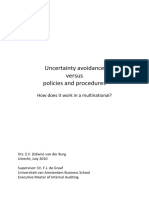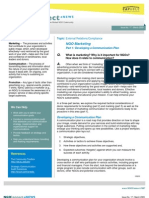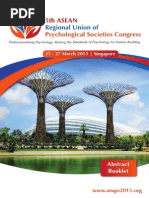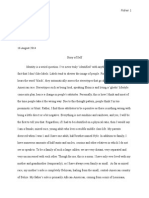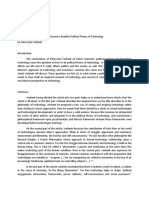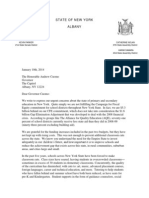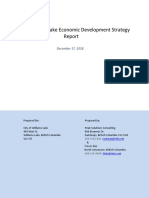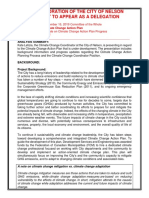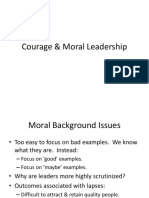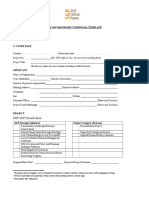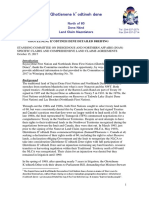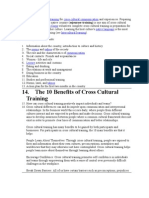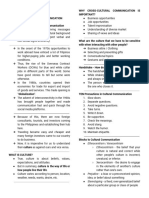Challenges and Solutions To Global Leadership
Challenges and Solutions To Global Leadership
Uploaded by
Christine McCallaCopyright:
Available Formats
Challenges and Solutions To Global Leadership
Challenges and Solutions To Global Leadership
Uploaded by
Christine McCallaOriginal Description:
Original Title
Copyright
Available Formats
Share this document
Did you find this document useful?
Is this content inappropriate?
Copyright:
Available Formats
Challenges and Solutions To Global Leadership
Challenges and Solutions To Global Leadership
Uploaded by
Christine McCallaCopyright:
Available Formats
1
Challenges and Solutions to Global Leadership
Christine Ann McCalla, NorthCentral University
Abstract
Managing employees globally creates significant challenges based on cultures, personalities,
objectives, and milestones outcomes. Additionally, profitability requires that cohesion between
stakeholders, management, and employees be achieved. The various relationships and their
interactions are in themselves subjective and open to interpretation, but the strategic plans
implemented are the guiding influence the organization requires to ensure a successful
destination. Communication is key to knowledge transference regardless of the level, education,
or expertise of the employee, and if articulated in a clear, concise manner, every employee can
make significant contributions towards the strategic plan.
Introduction
The onsite environment and the global environment are similar to each other as the respective
leaders must share the same attributes, except the e-leader must have a greater range and depth of
skills. Additionally, the e-leader has challenges present in his daily environment unique to him
including scheduling, accessibility to resources including personnel and human capital
management, and gaining and retaining collaboration and integrity from both the followers and
the team in general.
Merits of Trust and Respect Among Employees and How it Affects Employee Performance
and Commitment, as Well as the Bottom Line of the Organization
The success of the mentoring and trust varies based on the type of environments and leadership.
Savolainen (2014), p 45-46, noted that Work, instructions, leadership, feedback, follow-up and
training are often in a digital format. As a result, the technological dependence organizational
cultures have fostered may create some differences while retaining similarities including
Savolainens p 46 face to face interaction vs. project management precision (both e-working and
onsite). The outcome of these contrasts are that poor management directly impacts the bottom
line, compensation, and incentives. Even worse, the global environment is often staffed by
personnel in varying locations and cultures, and in this case poor management skills can create
poor customer service, learning and growth opportunities, professional development, lack of
management confidence and the resulting buy-in. The appropriate skills must be present to
facilitate trust to result in any organizational growth, both financial and personnel.
Formulate examples of how E-leaders Can Build Trust In Followers Through TechnologyMediated Interaction
Saonee, et al. (2011) identifies trust as a trend arising due to the emphasis on collaboration and
changes in technology, p 274, requiring ... reconfigured exchange and the coordination of work
across distance and time. Additionally, Saonee, et al. addresses trust in e-leadership
environments through the utilization of the following factors as a conceptual framework: (1)
social network approach and structural position, p281, (2) boundary conditions, p 282, (3) trust
and trust centrality, p 282, and (4) communication and communication centrality, p 283.
Table 1: Trust & Technology-Mediation Conceptual Framework
The social network approach and structural position create the belief that collaboration is more
effective and efficient depending on the dynamic and the personalities of the team. As a result,
the team can move quicker or slower depending on the skillset of the group members and the
abilities to capitalize on the individual and the collaborative skillset. Boundary conditions are
more aptly described by Savolainens technological mediation includes possible occurrence due
to geographical, cultural or temporal causes, p 47. Saonee, et al. p 286, describes ...
conceptual linkages (i.e., communication trust, trust performance)... In
this context, the more communicative the team member, the more likely they are to receive
acclaim and hence remembered as substantially contributive members. As a result, there may be
delays in the e-leaderships acknowledgement of the trust and performance dynamic to other
effective team members who are less communicative but productively reliable.
Saonee, et al. p 286, described that the communication interaction created impacts varying levels
of trustworthiness perceptions. Additionally, the authors describes the project management
impact and efficiency the team experiences, as the competency and speed are not always relative.
My interpretation of this observation is that colleagues may experience difficulties which may be
appropriately communicated, but the e-leader may not appreciate the level of performance or
may feel under-performance has occurred. The frequency of the communication may create
credibility and reflect sincerity of the relationship and the progress of deliverables, but at the end
of the day the e-leader makes the final decision. Trust and trust centrality translates to meeting
the expectation of collaboration, and the role each participant plays in the collaboration process the believability factor. Will the scheduled milestones be met as expected, and should the eleader or appropriate delegate create monitoring mechanisms to ensure that the team integrity is
maintained? Communication and communication centrality, Saonee, et al. p 283, addresses a
number of factors including the absence of relationships and prior collaborations. Here
communication alone is not enough to facilitate productivity, instead it can be a challenge, that
can be eliminated through the satisfactory performance of collaboration, project management,
and deliverables. Here effective and efficient project management is the solution, and along with
it the relevant communication of progress, and the timeliness thereof. With this project
management plan, trust can be fostered, developed, and maintained.
Differentiate Skills That Are Needed by a Traditional, On-site Leader and an E-leader in a
Global Environment
While both on-site leaders and e-leaders may include similar and contrasting values, the e-leader
requires Savolainen, p 47, stronger skills, greater sensitivity, multi-cultural mindset, and a 24x7
orientation, as well as his problem solving capacity, social skills, and professional know-how.
The accomplishment of effective e-leaders requires Pinjani & Palvias (2013) people, process,
and technology, p 144, which results in a greater depth of skills. Walton (2013) describes the ...
challenges familiar to technical communicators: identifying stakeholders needs, crafting
effective information products, and building credibility necessary to influence stakeholdersall
complicated by cross-cultural contexts., p 86. To adequately prepare the e-leaders skills,
mentoring, professional development, scalability, persuasion, integrity, collaboration, task
interdependence, and crisis management are required.
While these attributes are required by both on-site and e-leaders, the onsite leader has the major
advantage of Pinjani & Palvias face-to-face interaction, direct communication, personal
knowledge and observation of both subordinates / team members, supervisors, and vice versa
(camaraderie). In the global environment, it is the opposite. In a global environment, without
proper management frustration can also become an attribute as all team members must be aware
of interdependency vs codependency. In the onsite environment the leader has the opportunity to
spontaneously bring a superior as an independent observer in person, but the e-leader will have
the additional challenge of scheduling a superior to be present in person. Given the level of
confidentiality present, the team can become aware and temporary behavioral changes may occur
as technological observation and monitoring may not be 100% conclusive.
For this reason, all e-leaders require professional development. The people, process, and
technology aspect to an e-leader requires crisis management to ensure that identification of
appropriate measures are taken timely, and how to substitute and manage the global environment
as if it were an onsite environment.
Propose How Leaders and E-leaders Can Ensure Their Messages Are Articulated Clearly
to Motivate Not Only Employees, but All Stakeholders Through Cross-cultural and
Intercultural Communications
Leaders and e-leaders can articulate their messages motivating employees and stakeholders
through cross-cultural and intercultural communications by using Zander, et als (2013) critical
challenges, p 229, and Harnishs (2002), pp 32 -34, One-Page Strategic Plan (OPSP). These
challenges are goal alignment, knowledge transfer, and motivation. Additionally, the stakeholders
must be clearly defined and include profitability metrics / bottom line, customers, community,
governance teams, ownership teams including sales and marketing, owners, etc.
Zander, et als (p 229) goal alignment refers to sustaining environments including virtual
environments, in which goal conflicts can be detected, knowledge transfer which must be
managed to ensure effective communication and remove distractions arising from cultural
differences including poor communication and trust. Finally, Zander, et als challenge of
motivation, p 229, must be managed as primarily employees preferences and needs are not
easily recognizable. Kaplan & Nortons balanced scorecard described in Costa Oliveiras (2014)
univocal network of relationships, established by the original model
(learning and growth internal processes customer finance)... addresses
all three challenges by modeling the relevant perspectives. Additionally, the challenges of goal
alignment, knowledge transfer, and motivation can be addressed using an integrated framework
of Kaplan & Nortons balanced scorecard and Harnishs, pp 32 -34, OPSP. Harnishs OPSP
includes numerous internal processes and learning and growth drivers from which all three
challenges can be identified, derived, and the team and stakeholders can benefit from including
the sandbox, actions, key thrusts, and key initiatives. As a result, every player including leaders,
stakeholders, and team followers are owners, and can identify the strategic action, costs, benefits,
and relevant rewards.
Table 2: Conceptual Framework of Integrated Balanced Scorecard and One-Page Strategic Plan
How Leaders and e-leaders Can Ensure Their Messages Are Articulated
Customer Service Perspective
a. Treat employees as customers
a.
b. Create team leaders (traditional and e-leaders)
metrics as customer returns
b.
c. Consider employees as stage 1 of every marketing /
sales plan
c.
a.
b.
c.
d.
e.
f.
g.
h.
Internal Processes Perspective
Strategic planning including productivity drivers
(Harnish)
Identify KPIs (Harnish)
Goal alignment as a stakeholder; everyone comes
along (Harnish)
Employees as stakeholders
Identify trends (Harnish)
SWOT analysis (Harnish)
Motivation / reward, celebration, critical #s,
(Harnish)
Knowledge transfer / rocks, accountability, and
quarterly priorities (Harnish)
a.
b.
c.
d.
e.
Finance Perspective
Include financial metrics in the stakeholder
portfolios
Hold employees and leaders responsible for
financial performance by using Harnishs OPSP
Address bottom line impact by creating leader
accountability to team followers
Learning and Growth Perspective
Develop separate professional develop platforms for
both on-site and e-leaders and teams
Include metrics for human capital management to
support customer service and financial perspectives
Goal alignment / productivity drivers, trends, and
SWOT (Harnish)
Motivation (Harnish)
Knowledge transfer (Harnish)
Specific Challenges of Trust and Communication in Own Business Environment, and Then
Recommendations on How These Challenges Can Be Turned Into Opportunities
Savolainen noted several factors that presents challenges for e-business, interaction p 47,
communication p 53, leadership skills including range and management of emotional and
technicals skills p 57, and organization / project management. Face to face interaction creates an
opportunity to build structure and organization, while e-business presents a challenge of a
different sort: scheduling. Personnel working remotely or not physically present in the workplace
may have different work schedules. As a result contact must be scheduled and technology, e.g.
Skype or Google Hangouts, can create opportunities to create the same interaction as a face to
face meeting. The challenge of communication occurs as the leadership-follower dynamic has
less depth and availability, both on a personal and professional level. In the on-site environment,
the follower may feel supported enough that (s)he may randomly request meetings of both a
professional or personal nature. The e-business environment creates both the distance and
independence that the follower may be uncomfortable in this regard and the personal interaction
is limited to that of a professional nature. As a result, the leaders preferences may be ignored.
The challenge of the range and management of emotional and technicals skills extends to social
networking, technical competency, and the identification of ethical factors such as integrity and
honest representation. Social skills including active listening and undivided attention may be
limited during remote communication, while during face to face communication the leader is
more able to direct the followers attention to the matter at hand. Additionally, in a face to face
environment the leader has the flexibility of unscheduled project management meetings, first
thing in the morning or other time, to review the status of the workload, Blanchard (1982). This
communication is more productive as both parties are readily available to discuss, review
questions, and make edits. Snellman (2014), p 1254, Information and communication technology
(ICT) is a collaborative tool increasing the competitive advantage, innovation, and access of
resources including best skills, and core competencies. Along with this collaborative tool comes
the human resource element of frustration, competency, and availability, but consistent
availability increases effectiveness and efficiency. Personnel working remotely may have
challenges accessing their intranet, teleconferencing, etc. as a result of incompatible technology.
Body language may be interpreted subjectively, and what may seem to be disgruntled behavior
could be a sign of intense concentration or frustration. Unless the leader follower interaction is
face-to-face and frequent, misinterpretation may follow.
These challenges may be turned into opportunities using Snellmans key factors of trust in virtual
teams, p 1257. Trust can be established by setting leader expectations of coherence, clarity, trust,
positive attitudes and enthusiasm, and integration. This level of trust can be established through
the creation of policies and procedures, knowledge management, communication, and
transparency (clear expectation).
Conclusion
Regardless of the caliber of technology or the e-leader skills, trust is required by the entire team
and the organization due to the resources global environments require. As a result, transparency
is required at times even more than trust to ensure that human capital management is optimized
to ensure that goal alignment, motivation, and identification trends can be communicated to the
organization as a whole. To facilitate this, the e-leader ust acquire and retain the applicable skills
as the team and not just the e-leader performs and accomplishes goals. All stakeholders require
the expected returns their investment demands.
10
References
Bidault, F., de la Torre, J. R., Zanakis, Ring, P. S. (2015) Willingness to Rely on Trust in Global
Business Collaborations: Context vs. Demography. Journal of World Business, August 2016,
1-19
Blanchard, K. H. & Johnson, S. (2003). The One Minute Manager, William Morrow and
Company, Inc.
Costa Oliveira, H. M. (2014). The Balanced Scorecard Operating as a Risk Management Tool.
Review Of Economic Studies & Research Virgil Madgearu, 7(2), 41-57
Ford, R. C., Piccolo, R. F. & Ford, L. R. (2016) Strategies for Building Effective Virtual Teams:
Trust Is Key. Business Horizons, September 2016, 1-10
Grosse, C. U. (2002). Managing Communication within Virtual Intercultural Teams. Business
Communication Quarterly, 65(4), 22-38
Harnish, V. (2002) Mastering the Rockefeller Habits: What You Must Do to Increase the Value
of Your Growing Firm, 31 - 34
Hill, N. S., Kang, H. J., & Seo, M. G. (2014) The Interactive Effect of Leadermember
Exchange and Electronic Communication on Employee Psychological Empowerment and
Work Outcomes. The Leadership Quarterly, 25(4), 772783
Lee, C., & Chang, J. (2013). Does Trust Promote More Teamwork? Modeling Online Game
Players' Teamwork Using Team Experience as a Moderator. Cyberpsychology, Behavior And
Social Networking, 16(11), 813-819. doi:10.1089/cyber.2012.0461
Lin, H. (2006). Understanding Behavioral Intention to Participate in Virtual Communities.
Cyberpsychology & Behavior: The Impact of the Internet, Multimedia and Virtual Reality
On Behavior and Society, 9(5), 540-547
Liu, J., Rau, P. P., & Wendler, N. (2015). Trust and online information-sharing in close
relationships: a cross-cultural perspective. Behaviour & Information Technology, 34(4), 363374. doi:10.1080/0144929X.2014.937458
11
Kupritz, V. W., & Hillsman, T. (2011). The Impact of the Physical Environment on Supervisory
Communication Skills Transfer. Journal Of Business Communication, 48(2), 148-185.
doi:10.1177/0021943610397269
Panteli, N., & Tucker, R. (2009). Power and Trust in Global Virtual Teams. Communications Of
The ACM, 52(12), 113-115. doi:10.1145/1610252.1610282
Pinjani, P. & Palvia, P. (2013). Trust and Knowledge Sharing in Diverse Global Virtual Teams.
Information & Management, 50(4), 144-153
Park, M. J., Choi, H., Kim, S. K., & Rho, J. J. (2015). Trust in Governments Social Media
Service and Citizens Patronage Behavior, Telematics and Informatics, 32(4),629-641
Retrieved from https://gazelles.com/g/one-page-tools/strategy
Savolainen, T. (2014). Trust-Building in e-Leadership: A Case Study of Leaders' Challenges and
Skills in Technology-Mediated Interaction. Journal Of Global Business Issues, 8(2), 45-56
Saafein, O. & Shaykhian, G. A. (2014). Factors Affecting Virtual Team Performance in
Telecommunication Support Environment. Telematics and Informatics. 31(3), 459-462
Saonee, S., Manju, A., Suprateek, S., & Kirkeby, S. (2011). The Role of Communication and
Trust in Global Virtual Teams: A Social Network Perspective. Journal Of Management
Information Systems, 28(1), 273-309
Snellman, C. L. (2014). Virtual Teams: Opportunities and Challenges for e-Leaders. Procedia Social and Behavioral Sciences. 110(24), 1251-1261
Tourangeau, A., Cranley, L., Laschinger, H., & Pachis, J. (2010). Relationships Among
Leadership Practices, Work Environments, Staff Communication and Outcomes in Longterm Care. Journal Of Nursing Management, 18(8), 1060-1072. doi:10.1111/j.13652834.2010.01125.x
Walton, R. (2013). How Trust and Credibility Affect Technology-Based Development Projects.
Technical Communication Quarterly, 22(1), 85-102
Zander, L., Zetting, P. & Mkel, K. (2013). Leading Global Virtual Teams to Success.
Organizational Dynamics, (42)3, 228-237
You might also like
- QuestionnaireDocument3 pagesQuestionnaireblueswan82% (11)
- Case 6.1. Brazil's Economic Boom Needs More Talent: Assignment #5Document3 pagesCase 6.1. Brazil's Economic Boom Needs More Talent: Assignment #5Joe Morales Jr.No ratings yet
- Cultural Intelligence in The World of Work Past Present FutureDocument199 pagesCultural Intelligence in The World of Work Past Present FutureKorie Arsie100% (1)
- Final Assessment Report From Teneo Risk On The St. Louis Metropolitan Police DepartmentDocument42 pagesFinal Assessment Report From Teneo Risk On The St. Louis Metropolitan Police DepartmentWUSA9-TVNo ratings yet
- Roots of Conflict, Violence and PeaceDocument18 pagesRoots of Conflict, Violence and PeaceTrieu Huy HaNo ratings yet
- A Model of Strategic Entrepreneurship The Construct and Its DimensionsDocument27 pagesA Model of Strategic Entrepreneurship The Construct and Its DimensionsAnthonyUniqueNo ratings yet
- Uncertainty Avoidance Survey QuestionnaireDocument44 pagesUncertainty Avoidance Survey QuestionnaireAnonymous FcV2vHkNo ratings yet
- Ashesi Innovation Experience 2014 LogbookDocument16 pagesAshesi Innovation Experience 2014 LogbookaixupdatesNo ratings yet
- Council Requested Budget Adjustment AdditionsDocument58 pagesCouncil Requested Budget Adjustment AdditionsDarren KrauseNo ratings yet
- The Efficacy of Talent Management in International Business The Case of European MultinationalsDocument16 pagesThe Efficacy of Talent Management in International Business The Case of European MultinationalstheonlypaulNo ratings yet
- External Relations-Compliance - NGO Marketing Part 1 - Developing A Communication PlanDocument3 pagesExternal Relations-Compliance - NGO Marketing Part 1 - Developing A Communication PlanYogesh R. HadoleNo ratings yet
- 2018 ActionStrategy Planning Guide For Tribal LeadersDocument12 pages2018 ActionStrategy Planning Guide For Tribal Leadersactionstrategy1No ratings yet
- Corporate Trainer Interview QuestionsDocument2 pagesCorporate Trainer Interview QuestionsdushtmanavNo ratings yet
- Culture and International EntrepreneurshipDocument15 pagesCulture and International EntrepreneurshipsakshiNo ratings yet
- Adolescent ResilienceDocument39 pagesAdolescent ResilienceRobin MarkNo ratings yet
- Kabul University Institute of Public Policy and Administration Invitation Letter From Maria BeebeDocument2 pagesKabul University Institute of Public Policy and Administration Invitation Letter From Maria BeebeInayet HadiNo ratings yet
- What Is Public Narrative.3.8.07Document15 pagesWhat Is Public Narrative.3.8.07Nikita ZhukNo ratings yet
- Samuel PipimDocument17 pagesSamuel PipimSamuel Pipim50% (2)
- Annual Report: John Humphrey Centre For Peace and Human RightsDocument24 pagesAnnual Report: John Humphrey Centre For Peace and Human RightsJohn Humphrey Centre for Peace and Human RightsNo ratings yet
- Chloe Slavin RésuméDocument1 pageChloe Slavin RésuméChloe SlavinNo ratings yet
- Business Models and Competitive Advantagea Dynamic ApproachDocument17 pagesBusiness Models and Competitive Advantagea Dynamic Approachdibrali2014No ratings yet
- ARUPS2015 Abstract BookDocument50 pagesARUPS2015 Abstract BookMary Donnavel Libron BuloronNo ratings yet
- Cascone Essay - ASPA Founders' Fellows ApplicationDocument5 pagesCascone Essay - ASPA Founders' Fellows ApplicationNatalie TroianiNo ratings yet
- Apec Concept Note2Document3 pagesApec Concept Note2Zainudin MohamedNo ratings yet
- Corporate Governance EffectsDocument13 pagesCorporate Governance EffectsAhmed MohyeNo ratings yet
- The Role of Financial Ratios in Signaling Financial Distress: Evidence From The Kenyan Listed Commercial BanksDocument31 pagesThe Role of Financial Ratios in Signaling Financial Distress: Evidence From The Kenyan Listed Commercial BanksRitu KcNo ratings yet
- Story of SelfDocument4 pagesStory of Selfapi-276997018No ratings yet
- Social Integration of The Hong Kong South Asian PopulationsDocument16 pagesSocial Integration of The Hong Kong South Asian Populationsrrm364No ratings yet
- Vision 2035 DraftDocument53 pagesVision 2035 DraftJoe EdgeNo ratings yet
- Philosophy of Science CommentaryDocument2 pagesPhilosophy of Science CommentaryLhee Orlan MegarbioNo ratings yet
- Cuomo CFE Funding Support Letter Final 1Document3 pagesCuomo CFE Funding Support Letter Final 1GothamSchools.orgNo ratings yet
- Reflexive Government For Sustainable DavelopmentDocument477 pagesReflexive Government For Sustainable DavelopmentIne Net100% (1)
- FINAL Williams Lake Econ Strategy-Dec 17-2018Document36 pagesFINAL Williams Lake Econ Strategy-Dec 17-2018WL TribuneNo ratings yet
- Mughal Rule and Ghunghat of Indian WomenDocument5 pagesMughal Rule and Ghunghat of Indian Womenekram.kabir100% (1)
- webPEER 2013 19 Mieler PDFDocument167 pageswebPEER 2013 19 Mieler PDFAbderrahmane SaidNo ratings yet
- Farm Pond Neighborhood ReportDocument66 pagesFarm Pond Neighborhood ReportDaniella FergussonNo ratings yet
- Association of Management Development Institutions in South AsiaDocument5 pagesAssociation of Management Development Institutions in South AsiaShoaib MohammedNo ratings yet
- Nelson Climate Change Plan UpdateDocument37 pagesNelson Climate Change Plan UpdateBillMetcalfeNo ratings yet
- Teresa Wilson ResumeDocument2 pagesTeresa Wilson ResumeThe State NewspaperNo ratings yet
- Letter From Shani WilsonDocument1 pageLetter From Shani WilsonNews10NBCNo ratings yet
- Chase Omalley Fellows ApplicationDocument6 pagesChase Omalley Fellows Applicationapi-565858319No ratings yet
- What Is Your (Roberta's) Effort To Date?Document12 pagesWhat Is Your (Roberta's) Effort To Date?Lu Xiyun50% (2)
- Leadership Program EssayDocument28 pagesLeadership Program EssayQamran Hassan SanvyNo ratings yet
- ICCH14 Abstract BookDocument166 pagesICCH14 Abstract BookInstitute for Circumpolar Health ResearchNo ratings yet
- Arctic Security Report - 2012Document54 pagesArctic Security Report - 2012ares_01No ratings yet
- Courage & Moral LeadershipDocument26 pagesCourage & Moral LeadershipChristina Cupido100% (1)
- Prize Giving Speech 2013Document6 pagesPrize Giving Speech 2013zunnyngozNo ratings yet
- Safer 6th Street Initiative MemoDocument6 pagesSafer 6th Street Initiative MemoCBS Austin WebteamNo ratings yet
- Sustainability EssayDocument8 pagesSustainability EssayBiswa KiranNo ratings yet
- RAVP Consultation Summary Report. Richmond Airport Vancouver ConsultationDocument201 pagesRAVP Consultation Summary Report. Richmond Airport Vancouver ConsultationBill LeeNo ratings yet
- Public Policy Assignment LetterDocument4 pagesPublic Policy Assignment Letterapi-268452935No ratings yet
- Accredited Institutions in GhanaDocument14 pagesAccredited Institutions in GhanaSolomon Sakyi AboagyeNo ratings yet
- Perceived Organisational Support - FinalDocument21 pagesPerceived Organisational Support - FinalPatrick YesandroNo ratings yet
- SGP Generic Project Proposal Template-Guidelines - OP6Document12 pagesSGP Generic Project Proposal Template-Guidelines - OP6Paul Kudzaishe KuonaNo ratings yet
- Building Design Index Analysis Model To Improve User Comfort Within "Efficient Energy Used"Document9 pagesBuilding Design Index Analysis Model To Improve User Comfort Within "Efficient Energy Used"Mohammad PirmohammadiNo ratings yet
- Women at Work Balancing Career and Personal GoalsDocument18 pagesWomen at Work Balancing Career and Personal Goalsstellacrasto12No ratings yet
- The Understandings of Four Types of Entrepreneurial VenturesDocument26 pagesThe Understandings of Four Types of Entrepreneurial VenturesNguyen Ngoc Long (FGW HN)No ratings yet
- UNDP Procurement Strategy 2015-17Document20 pagesUNDP Procurement Strategy 2015-17UNDPNo ratings yet
- Effectiveness Evaluation of Behavioural Training and Development ProgrammesDocument9 pagesEffectiveness Evaluation of Behavioural Training and Development Programmesthesij100% (1)
- Ghotlenene Kodtineh Dene BriefingDocument14 pagesGhotlenene Kodtineh Dene BriefingNunatsiaqNews100% (1)
- Winning Strategies for a Sustainable Future: Reinhard Mohn Prize 2013From EverandWinning Strategies for a Sustainable Future: Reinhard Mohn Prize 2013No ratings yet
- Organisations and Leadership during Covid-19: Studies using Systems Leadership TheoryFrom EverandOrganisations and Leadership during Covid-19: Studies using Systems Leadership TheoryNo ratings yet
- PSA ProjectDocument13 pagesPSA ProjectAlla AnianovaNo ratings yet
- TG SampleDocument5 pagesTG Samplejean ApostolNo ratings yet
- Developing Intercultural Communicative CompetenceDocument17 pagesDeveloping Intercultural Communicative CompetenceLuciana R LarregainNo ratings yet
- Speech Translation Bono National Prayer Breakfast AddressDocument7 pagesSpeech Translation Bono National Prayer Breakfast AddressoltiboyevbobosherNo ratings yet
- MulticulturalismoDocument16 pagesMulticulturalismoNatalia Leon GomezNo ratings yet
- Binalonan, Pangasinan: Coping With The Challenges of Intercultural CommunicationDocument4 pagesBinalonan, Pangasinan: Coping With The Challenges of Intercultural CommunicationAngelica Manalaysay MacedonioNo ratings yet
- COURSE WEBSITE: HTTPS://WWW - Royalroads.ca/programs/master-Arts-Global-LeaderDocument3 pagesCOURSE WEBSITE: HTTPS://WWW - Royalroads.ca/programs/master-Arts-Global-LeaderSehnoor KaurNo ratings yet
- Introduction To Cultural Sensitivity in HealthcareDocument10 pagesIntroduction To Cultural Sensitivity in HealthcareMedical Education Gomal Medical CollegeNo ratings yet
- Purposive CommunicationDocument4 pagesPurposive Communicationjames van naronNo ratings yet
- Cross-Cultural Negotiations - Almond Chemical Case AnalysisDocument15 pagesCross-Cultural Negotiations - Almond Chemical Case AnalysisSafa AamirNo ratings yet
- Pacific Southbay College, Inc: Humss 11-BDocument46 pagesPacific Southbay College, Inc: Humss 11-BAron Adarson100% (1)
- GED1Document8 pagesGED1VincentNo ratings yet
- Syllabus Traffic Management and Accident Investigation With DrivingDocument8 pagesSyllabus Traffic Management and Accident Investigation With DrivingBenedicto CabeltoNo ratings yet
- The Cultural Dimensions of NCIDocument30 pagesThe Cultural Dimensions of NCIAura ToaderNo ratings yet
- GLSD3201 CourseOutline Spring2020Document7 pagesGLSD3201 CourseOutline Spring2020Kristy LeungNo ratings yet
- Cross-Culture TrainingDocument2 pagesCross-Culture TrainingparimittalNo ratings yet
- Intercultural Communication: Ms. Aicha Ellen A. BalabaDocument10 pagesIntercultural Communication: Ms. Aicha Ellen A. BalabaAicha Ellen BalabaNo ratings yet
- Guide To EFL PlanningDocument10 pagesGuide To EFL Planningm1852259323No ratings yet
- AERO World Language StandardsDocument39 pagesAERO World Language StandardsTimmyNo ratings yet
- Types of Metaphors of OrganisationDocument7 pagesTypes of Metaphors of OrganisationVisesh0% (1)
- Religion and Social Communication in Asia: Towards A Research AgendaDocument16 pagesReligion and Social Communication in Asia: Towards A Research Agendagabby macaNo ratings yet
- Altahri (2013) Issues and Strategies of Subtitling Cultural ReferencesDocument194 pagesAltahri (2013) Issues and Strategies of Subtitling Cultural ReferencesSilvana CarvalhoNo ratings yet
- Communication GlobalizationDocument11 pagesCommunication GlobalizationJamesvan Naron100% (1)
- Aesthetic Issues in Translation of Azerbaijani Poetry Into EnglishDocument79 pagesAesthetic Issues in Translation of Azerbaijani Poetry Into EnglishJdjddk JdjemdNo ratings yet
- 2 - Cross-Cultural CommunicationDocument2 pages2 - Cross-Cultural CommunicationEleina BernardoNo ratings yet
- Language Barriers in The ClassroomDocument13 pagesLanguage Barriers in The ClassroomLyth LythNo ratings yet
- Arts-Based MethodsDocument316 pagesArts-Based MethodsAhmad El TahanNo ratings yet
- AppleDocument11 pagesAppleSayyid Muhammad AliNo ratings yet






